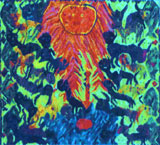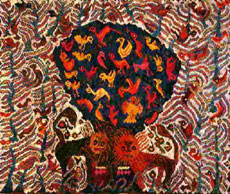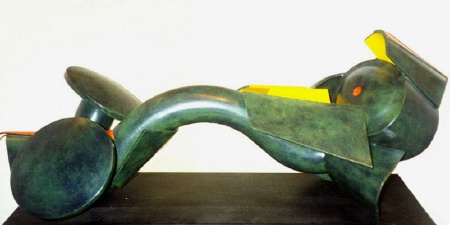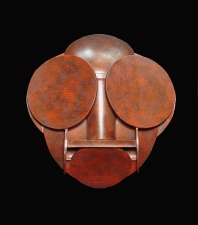THE 60s
and THE 70s:
continuity and clash with the tradition
Separation and segregation are the foundation of ideological and legislative
apartheid system.
During the 60s and 70s both circulation and possibilty
of communication and education of the blacks were obstructed in any ways.
This are the decades of clash and continuity with the tradition, but also
of innovation for what artistic formation concerns.
Southafricans art centres were very important for the artistic evolution
and communication beetween the artists.
BLACK ART
The Evangelical
Lutheran Church Art largly
stimulated a new kind of production.

•TRORKE’S DRIFT ART CENTRE
In Natal, in the centre of rural Africa,
was founded in 1962 and was attended by both african and american
artists as the fomous Alina Ndebele (images).

Azaria Batha and John Muafangejo often choose biblical or
autobiographic themes.
•Shilakoe prefers water colour technic to describe with a powerful realism
the anguish of his people.
For economics reasons,essentially,
the centre closed in 1982, eccept for the artigianal production, that
still today exhibits ceramics and tissue drawing.

WHITE ART
AMADLOZI GROUP, 1963
About the production of white southafricans artists, That
group was centered on the search of a own and local language and way of
expression. Amadlozi infact is a zulu word for "ancestor spirit".Tha
centre was founded by Egon Guenther, inspirated by the pop art, op art and the so-called Hard
edge.
Tha artists had a common aim: to describe their "africanity"
Cecil Skotnes, Giuseppe Cattaneo produce engraved glasses and
paintings, while Sydney Kumalo and Edouardo Villa
expresse their personality through sculpture.
The overall style could be defined european, while the chooses of
iconography is typical african. The group With its intents had brief life.
EDUARDO VILLA
Edoardo Villa is one of South Africa's foremost sculptors. He was born in
Bergamo, Italy where he studied at the Andrea Fontini Art School. While studying
sculpture in Milan, Villa was conscripted into the army at the outbreak of World
War II. His first experience of South Africa was that of a prisoner of war in
1942.
After his release he remained in that country to pursue a career as a sculptor.
Even in his most abstract work, there are constant allusions to human themes, in
terms of structure, posture, attitudes, relationships and circumstances. Villa's
style developed significantly in the 1950s, when the influence of the aggressive
forms of the African environment led him to create his first constructed works,
using abstract elements cut from sheets and rods of steel, a medium he has used
extensively and masterfully. Aside from working in steel, Villa has also modeled
works for bronze and more recently began using the found shapes of polystrene
packaging.
 Edoardo
Villa was chosen to represent South Africa at the Venice Biennal on five
occasions and has been recognized with awards at the São Paulo Biennales of 1957
and 1959. His work has been shown in more than one hundred one-man and group
shows in Italy, Europe, England, Israel, South America, Africa and the United
States. In 1995, to celebrate the artist's 80th birthday, the Edoardo Villa
Museum was officially opened at the University of Pretoria, South Africa. Villa
lives and works at his home in Johannesburg, South Africa.
Edoardo
Villa was chosen to represent South Africa at the Venice Biennal on five
occasions and has been recognized with awards at the São Paulo Biennales of 1957
and 1959. His work has been shown in more than one hundred one-man and group
shows in Italy, Europe, England, Israel, South America, Africa and the United
States. In 1995, to celebrate the artist's 80th birthday, the Edoardo Villa
Museum was officially opened at the University of Pretoria, South Africa. Villa
lives and works at his home in Johannesburg, South Africa.





 Edoardo
Villa was chosen to represent South Africa at the Venice Biennal on five
occasions and has been recognized with awards at the São Paulo Biennales of 1957
and 1959. His work has been shown in more than one hundred one-man and group
shows in Italy, Europe, England, Israel, South America, Africa and the United
States. In 1995, to celebrate the artist's 80th birthday, the Edoardo Villa
Museum was officially opened at the University of Pretoria, South Africa. Villa
lives and works at his home in Johannesburg, South Africa.
Edoardo
Villa was chosen to represent South Africa at the Venice Biennal on five
occasions and has been recognized with awards at the São Paulo Biennales of 1957
and 1959. His work has been shown in more than one hundred one-man and group
shows in Italy, Europe, England, Israel, South America, Africa and the United
States. In 1995, to celebrate the artist's 80th birthday, the Edoardo Villa
Museum was officially opened at the University of Pretoria, South Africa. Villa
lives and works at his home in Johannesburg, South Africa.